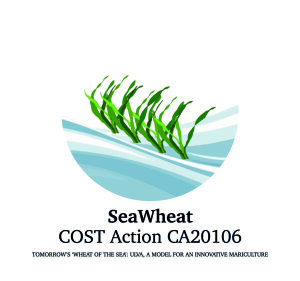Tomorrow´s Wheat of Sea: Ulva a model for an innovative maricultureite
PRESS RELEASE SEAWHEAT PROJECT of the COST Action (17.11.2021)
ULVA (SEA LETUCE): TOMORROW’S ‘WHEAT OF THE SEA’, A MODEL FOR AN INNOVATIVE MARICULTURE
Over the past decade, we have witnessed a growing interest in the development of marine coastal areas as a source of alternative, sustainable food production and other valuable products. We, a group of experts (105 specialists from 28 countries) pursuing these scientific and commercial interests in Europe, Asia, the Americas and beyond, propose to modernise and make more sustainable and healthy our traditional aquatic diet from our coastal seas through the EU-COST program.
The European Cooperation in Science and Technology (COST) Association supports an EU-funded program that enables researchers and innovators to set up a collaborative research network across a wide range of scientific disciplines. The COST funding organization supports Actions that provide networking opportunities to their participants, allowing them to jointly address scientific, technological and societal challenges through innovative ideas and initiatives. Our network aims to exploit the potential of marine seaweeds in Europe.
Building on the successes of previous EU and pan-European projects on seaweeds, and due to the unique characteristics of the green seaweed Ulva (commonly known as ‘sea lettuce’), we have identified these algae as the most suitable candidates and model organisms for a novel kind of European mariculture.
Species of Ulva have been extensively analysed for their value as food, feed, food ingredients (e.g., protein, carbohydrates, pigments, antioxidants), chemical constituents and medicinal properties. In mariculture, Ulva can be cultured in either land- or sea-based facilities. Ulva can produce more biomass per square meter than land plants (25-40 tonnes dry weight per hectare per year, compared to 2.1, 4.1 and 5.1 tonnes for soybean, wheat and maize, respectively). In addition, Ulva provides a fundamental ecosystem service as an ecological biofilter, supporting sustainability of the ever-growing industry of land- and sea-based fish farming, and preventing eutrophication in coastal waters
The SeaWheat COST Action (CA 20106 - TOMORROW’S ‘WHEAT OF THE SEA’: ULVA, A MODEL FOR AN INNOVATIVE MARICULTURE) combines interdisciplinary approaches to the sustainable use of marine resources, encompassing all facets of Ulva biology, ecology, aquaculture, engineering, as well as economic and social sciences. This Action will lead to the development of advanced science and technology, create business and employment opportunities in the maritime and coastal economies, and have a significant impact on societal welfare.
This COST Action fulfills the current ‘Societal Challenges Priorities’ of the European Horizon 2020 strategy for food security, and its implementation will contribute to the UN Sustainable Development Goals 14 (UNSDG) for the conservation and sustainable exploitation of natural resources.
